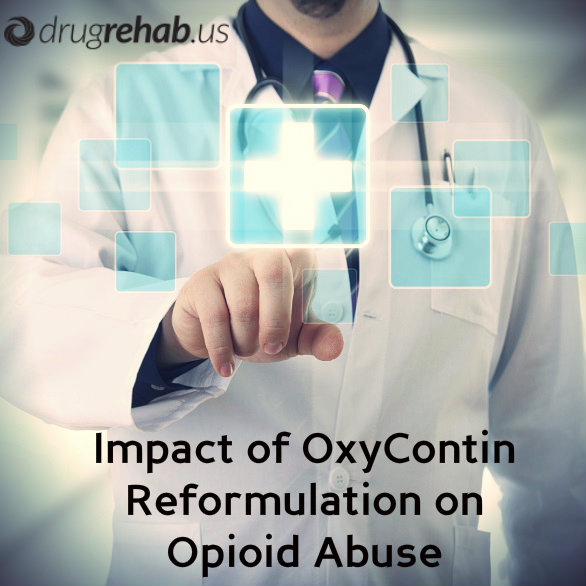Has The Reformulation Of OxyContin Helped Discourage Opioid Abuse?
OxyContin is the brand name of an extended-release painkilling medication that contains the opioid narcotic substance called oxycodone. In its original form, this medication was easy to tamper with and use as a source of opioid abuse. In response to this situation, the manufacturers of OxyContin reformulated the medication and made it considerably more tamper-resistant.
In a study published in June 2014 in the journal Drug and Alcohol Dependence, a team of U.S. researchers investigated whether the reformulation of OxyContin has had the desired effect of reducing the number of people who use the medication in a pattern of opioid abuse.
Oxycodone And OxyContin
Oxycodone is a generic opioid medication noted for its usefulness in the relief of various forms of serious or severe pain. Like all other opioid drugs and medications, it can trigger diagnosable problems with abuse or addiction when used in ways not sanctioned and monitored by a doctor. Some branded medications contain oxycodone in combination with other, less-powerful painkilling substances such as acetaminophen, aspirin or ibuprofen.
 Common examples of these combined medications include Percocet, Endocet, Percodan, Combunox and Roxicet. Other branded medications contain only oxycodone as their active ingredient. In addition to OxyContin, examples of these medications include Oxecta and Roxicodone.
Common examples of these combined medications include Percocet, Endocet, Percodan, Combunox and Roxicet. Other branded medications contain only oxycodone as their active ingredient. In addition to OxyContin, examples of these medications include Oxecta and Roxicodone.
OxyContin arrived on the U.S. market in 1995. It is specifically designed to provide extended amounts of pain relief to people affected by ongoing moderate or severe pain. Since it must produce its effects for many hours, an OxyContin tablet contains more oxycodone than most other available medications.
Unfortunately, in its original form, the medication was highly susceptible to crushing, chewing, dissolving and other forms of manipulation that made its oxycodone content available all at once. This fact made OxyContin a prominent target for abuse by people seeking the recreational drug effects of opioid intake. Widespread availability of the medication also contributed to its prominent role in opioid abuse in the U.S.
OxyContin Medication Reformulation
Along with addiction specialists, public health officials and drug enforcement officials, the manufacturers of OxyContin (Purdue Pharma LP) became well aware of the role that abuse of the medication played in the larger phenomenon of prescription opioid abuse.
In response, they withdrew the original formulation of OxyContin from the market and, in August 2010, released a new version of the medication that is substantially harder to use as a source of abuse. Specific steps taken during this reformulation include minimizing the availability of oxycodone even after crushing or other manipulation occurs, as well as making it impossible to pass a dissolved form of the medication through a syringe for injection.
Impact Of OxyContin Reformulation On Opioid Abuse
In the study published in Drug and Alcohol Dependence, researchers from the University of Kentucky and Purdue Pharma used interviews with a group of 189 adults with a prior history of abusing OxyContin to assess the effectiveness of the new formulation of the medication in discouraging opioid abuse. During these interviews, each participant was asked to compare their monthly level of involvement in opioid abuse before the OxyContin reformulation to their monthly level of involvement after the reformulation.
After analyzing the results of the interviews, the researchers found that 33 percent of the participants had tried to abuse the reformulated version of OxyContin in the month before the study. This contrasted with a 74 percent rate of monthly OxyContin abuse prior to the reformulation, as well as with a 96 percent rate of monthly abuse for any form of immediate-release oxycodone.
Individual rates for snorting and injecting the reformulated medication were also substantially lower than the snorting and injection rates associated with both the old version of OxyContin and oxycodone products that release immediately into the bloodstream. Overall, the study participants tried to abuse the reformulated OxyContin on roughly two out of 30 days. In contrast, abuse of the original version of the medication took place approximately 13 days a month, while abuse of immediate-release oxycodone took place about 20 days a month.
The researchers note that abuse of the old version of OxyContin among the study participants became much less common after the new version of the medication reached the market. In addition, they note that the participants rarely shifted from oxycodone abuse to heroin use. All told, they concluded that, at least among the people who took part in the study, the new version of OxyContin does not play the same prominent role in opioid abuse as the original version of the medication first released in the 1990s.
Do You Or Someone You Know Need Help With Prescription Drug Addiction?
Call Us Now! Help is Available 24/7!



